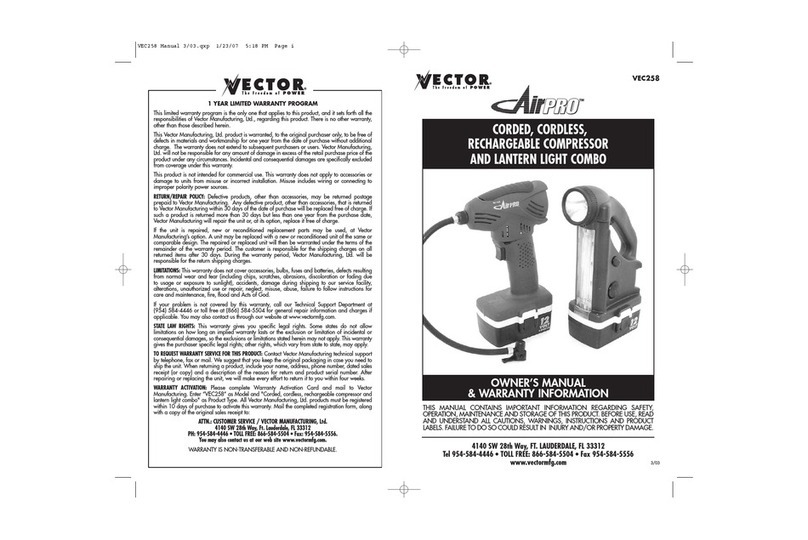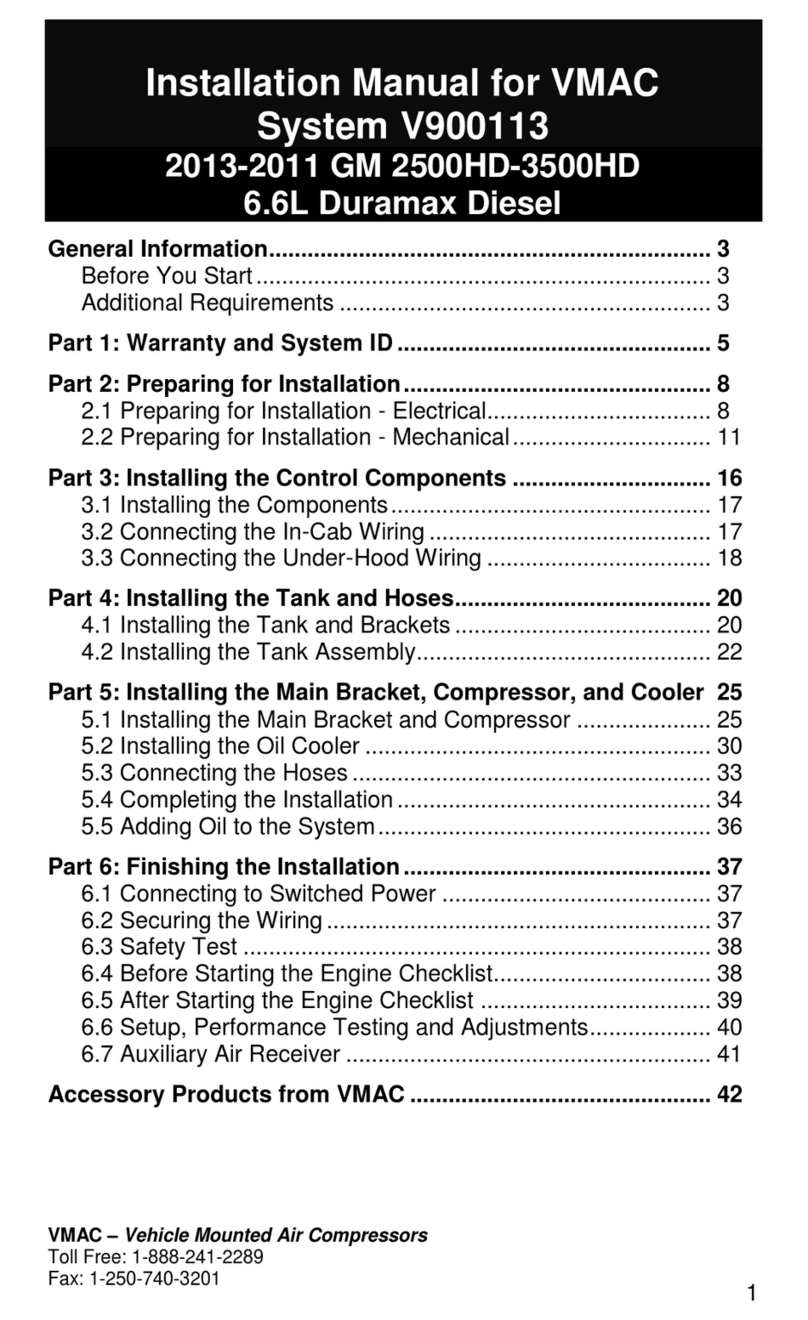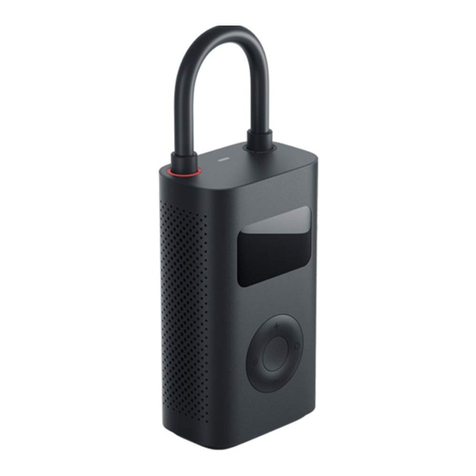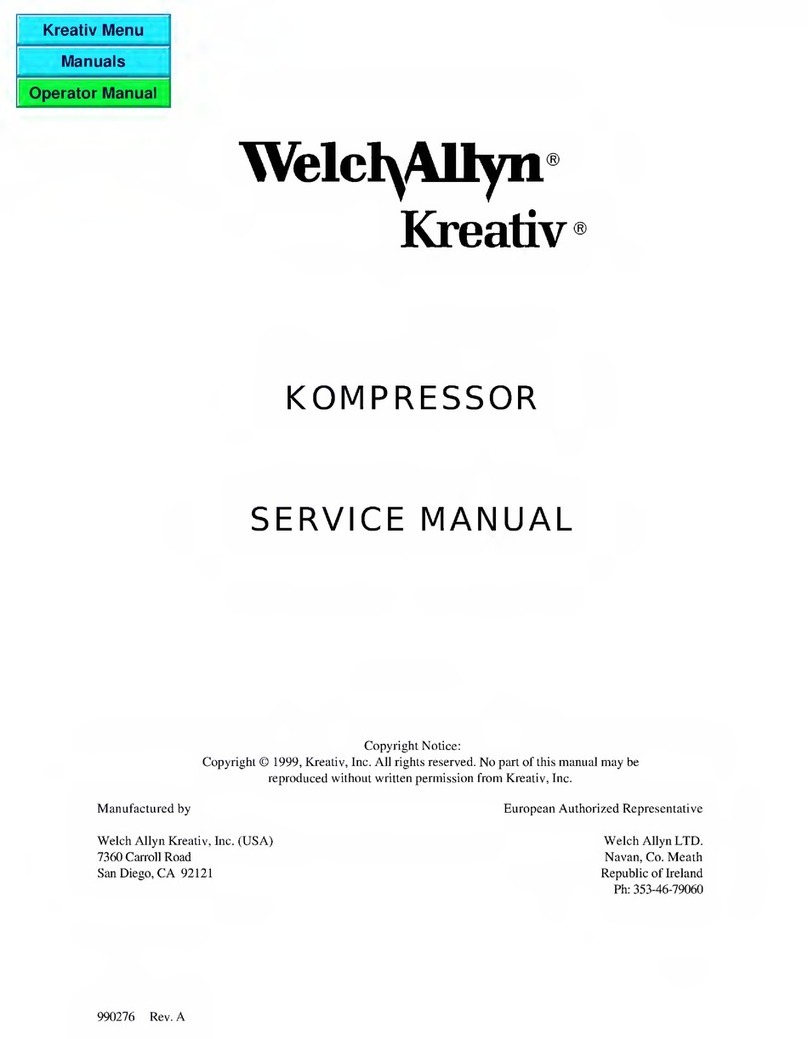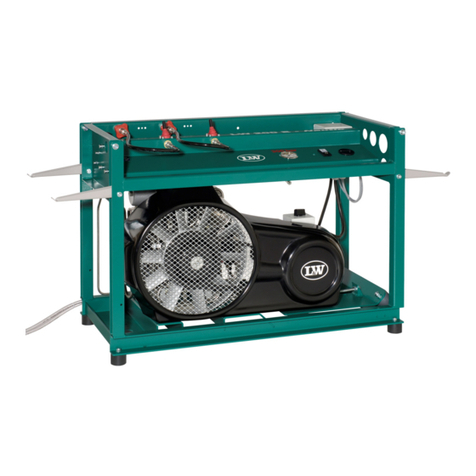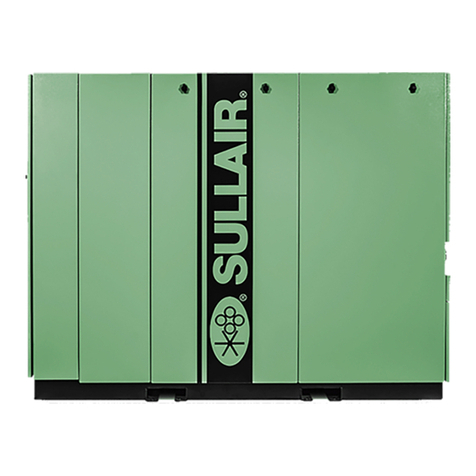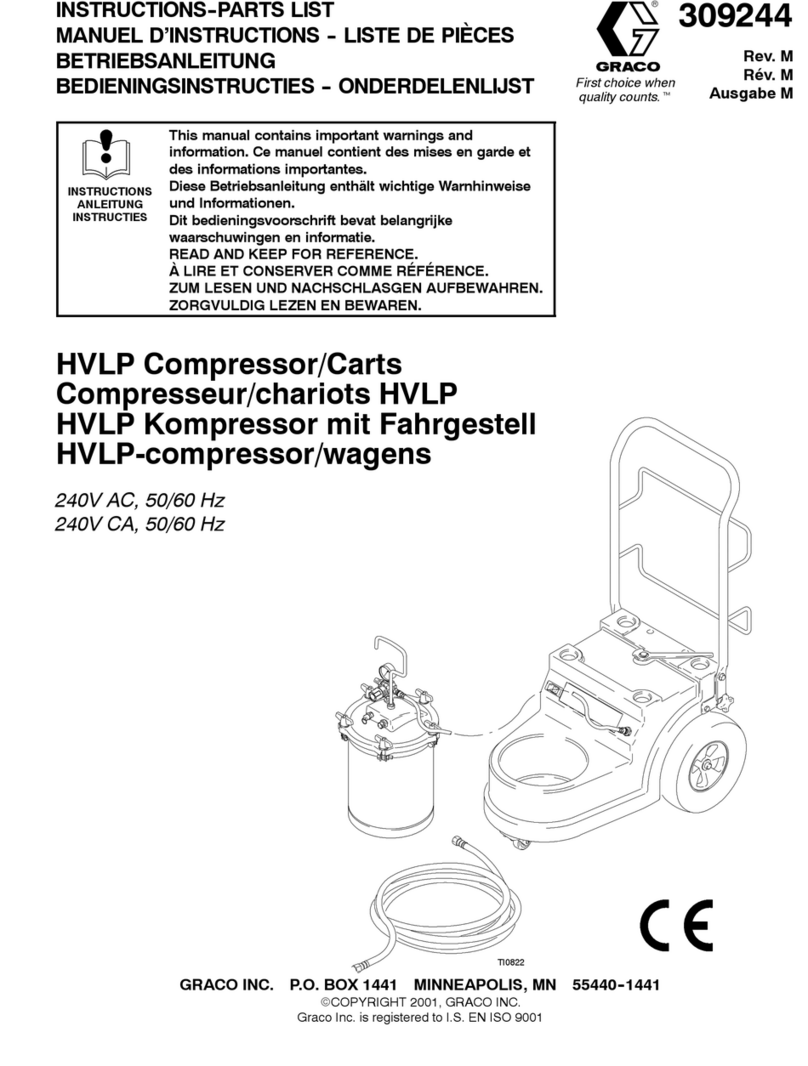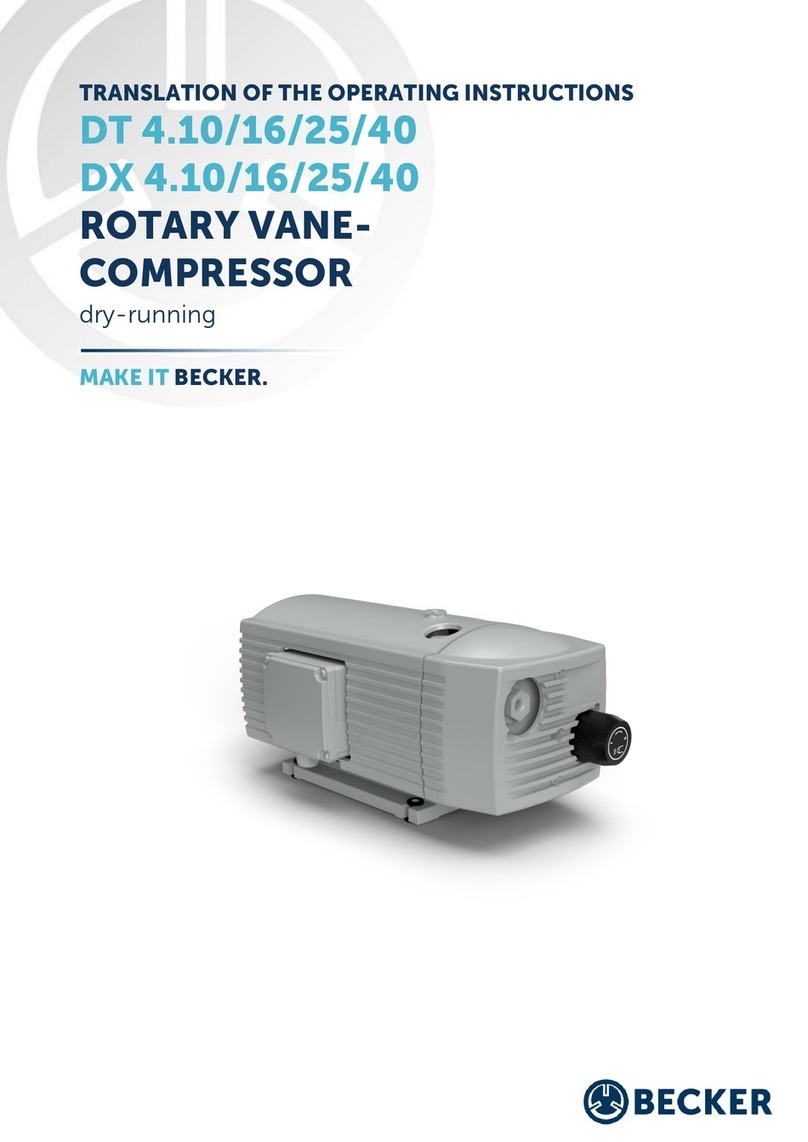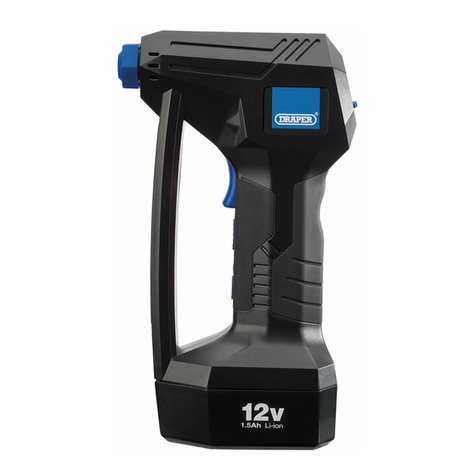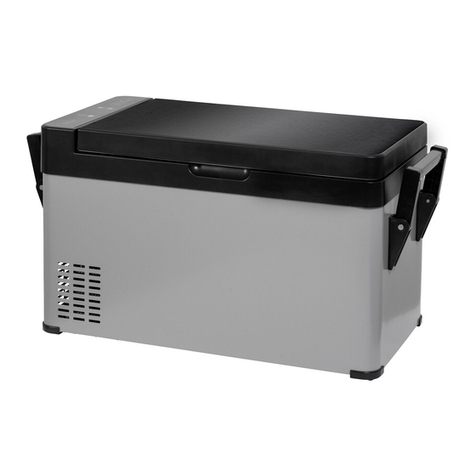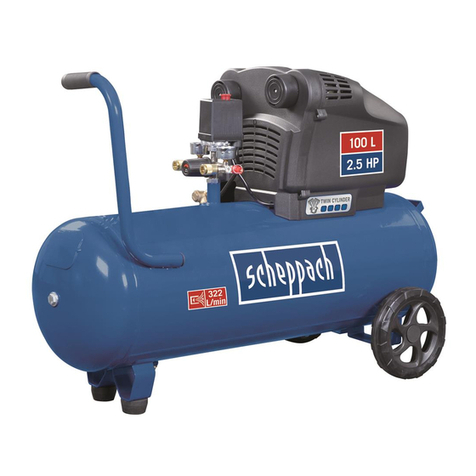GLENCO AIRMAC FU SHENG T20 User manual

OWNER’S MANUAL
Thank-you and congratulations for purchasing a high quality Airmac air compressor set.
It has been designed and manufactured to provide many years of safe and reliable
service if installed, operated and maintained in accordance with these instructions.
Please read and understand this manual before operating the compressor. Failure to
do so could result in death, severe injury and/or substantial property damage.
This manual should be considered a permanent part of the compressor and should
remain with it if resold.
72 Platinum Street, Crestmead, QLD 4132, Australia
Phone: (07) 3803 4100 Fax: (07) 3803 1255

Airmac Owner’s Manual
August 2006 © Glenco Manufacturing Pty Ltd Page 2 of 44
SAFETY
Compressed air can contain carbon monoxide, hydrocarbons and/or other poisonous
contaminants that can cause death or serious injury. The air compressor is not
designed, intended or approved for breathing air. Do not use compressed air for
breathing air applications without proper treatment. Do not use the compressor for any
gas other than air.
High voltage electricity can cause death or serious injury. All electrical installation or
repair work must be carried out by a licensed electrician. The compressor must be
connected to a properly grounded circuit of adequate capacity. Disconnect power
supply before servicing. Do not operate the compressor in wet conditions. Store
indoors.
Petrol and diesel fuels are flammable and poisonous and can cause death or serious
injury. Do not smoke or allow flames or sparks close to the engine.
Exhaust gas contains poisonous carbon monoxide that can cause death or serious
injury. Ensure adequate ventilation and do not operate the engine in a closed garage or
confined space.
The 12 Volt battery gives off explosive gases and its electrolyte contains corrosive acid,
either of which can cause death or serious injury. Keep sparks, flames and cigarettes
away from the battery and provide adequate ventilation when charging. Do not allow
the electrolyte to contact body or clothing.
Read and understand the separate Owner’s Manual for the petrol or diesel engine
before operating the compressor.
Moving parts can cause serious injury. Keep clear of the compressor during operation.
Do not operate with the drive guard removed. The compressor may start automatically.
Disconnect the power supply or switch-off engine before servicing.
Hot surfaces can cause serious injury. Do not touch metal surface of any compressor
component (including piping and tank) during or shortly after operation. Allow to cool
before servicing. Do not stand on the compressor or use it as a handhold.
Keep children, pets and unauthorized persons away from the compressor at all times.
High pressure air can cause death or serious injury. Do not bypass, modify or remove
the safety valve. Do not operate the compressor with a faulty safety valve or pressure
gauge. Do not direct the air stream at body. High pressure air can stir up dust and
debris that may be harmful. Release air slowly when draining condensate water or
depressurizing the compressor. Do not connect the compressor to air handling parts
that cannot withstand the compressor’s maximum design pressure (refer to tank
nameplate).

Airmac Owner’s Manual
August 2006 © Glenco Manufacturing Pty Ltd Page 3 of 44
Rusted, cracked or damaged air receiver tanks can explode and cause death or serious
injury and must be replaced. Drain tank daily or after each use through valve located at
bottom of tank. Release compressed air from the tank before servicing. Do not weld,
drill or otherwise modify the air receiver tank.
Wear personal protection equipment such as safety glasses, ear muffs and gloves when
operating the compressor or using compressed air. Wear a face mask or respirator
when spraying, blowing down or otherwise creating airborne mists or dust.
Do not spray flammable liquids in a confined area. Do not smoke while spraying and do
not spray where sparks, flames or other ignition sources (including the compressor) are
present.
Do not direct paint or other sprayed material at the compressor. Locate compressor as
far away from the spraying area as possible to minimize overspray accumulating on the
compressor and/or clogging its air filter(s).
Motors, electrical equipment and controls can cause electrical arcs that may ignite a
flammable gas or vapour. Do not operate or repair the compressor in or near a
flammable gas or vapour. Do not store flammable liquids or gases in the vicinity of the
compressor.
Before attempting to install, maintain, repair, store or transport the compressor, switch
off the unit, tag and lock out the power supply or disconnect the engine spark plug, and
carefully release all air pressure from the receiver tank, air hoses and/or piping.
Do not permit anyone to operate the compressor without proper instruction.

Airmac Owner’s Manual
August 2006 © Glenco Manufacturing Pty Ltd Page 4 of 44
INTRODUCTION
This Owner’s Manual is intended to comply with all Australian Occupational or
Workplace Health and Safety Regulations regarding the manufacturer’s provision of
information to the owner or purchaser of work plant. The information is correct at the
date of publication.
Due to Glenco Manufacturing Pty Ltd’s policy of continued product development, some
features and specifications of your new air compressor may vary slightly from those
shown herein. If after reading this manual you still have any questions or concerns
about your compressor, please contact your local authorized Airmac dealer or Glenco
Manufacturing Pty Ltd.
Previous purchasers of Airmac and Binford compressors may also rely on this manual
as a general guide for their units.

Airmac Owner’s Manual
August 2006 © Glenco Manufacturing Pty Ltd Page 5 of 44
PRODUCT FAMILIARIZATION
Typical 240 Volt Single Pump Air Compressor
NO. COMPONENT NO. COMPONENT
1 Compressor Pump 12 Wheel Mounting Bracket
2 Air Filter 13 Handle
3 Crankcase Breather 14 Wheel
4 Oil Fill Cap 15 Non-Return Valve
5 Oil Drain Plug 16 Unloading Line
6 Oil Level Sight Glass 17 Safety Valve
7 Compressor Pump Nameplate 18 Drain Valve
8 Electric Motor 19 Discharge Outlet
9 Air Receiver Tank 20 Pressure Gauge
10 Air Receiver Tank Nameplate 21 Pressure Switch
11 Drive Guard

Airmac Owner’s Manual
August 2006 © Glenco Manufacturing Pty Ltd Page 6 of 44
Typical 240 Volt Dual Pump Air Compressor
NO. COMPONENT NO. COMPONENT
1 Compressor Pump 11 Foot Mount
2 Air Filter 12 Non-Return Valve
3 Crankcase Breather 13 Unloading Line
4 Oil Fill Cap 14 Safety Valve
5 Oil Drain Plug 15 Drain Valve
6 Oil Level Sight Glass 16 Discharge Outlet Valve
7 Compressor Pump Nameplate 17 Pressure Gauge
8 Electric Motor 18 Pressure Switch
9 Air Receiver Tank 19 Dual DOL Starter
10 Drive Guard

Airmac Owner’s Manual
August 2006 © Glenco Manufacturing Pty Ltd Page 7 of 44
Typical 415 Volt Air Compressor ≤7.5 kW (10 hp)
NO. COMPONENT NO. COMPONENT
1 Compressor Pump 10 Drive Guard
2 Air Filter 11 Foot Mount
3 Crankcase Breather 12 Non-Return Valve
4 Oil Fill Cap 13 Safety Valve
5 Oil Drain Plug 14 Drain Valve
6 Oil Level Sight Glass 15 Discharge Outlet Valve
7 Electric Motor 16 Pressure Gauge
8 Air Receiver Tank 17 Pressure Switch
9 Air Receiver Tank Nameplate

Airmac Owner’s Manual
August 2006 © Glenco Manufacturing Pty Ltd Page 8 of 44
Typical 415 Volt Air Compressor ≥11 kW (15 hp)
NO. COMPONENT NO. COMPONENT
1 Compressor Pump 11 Non-Return Valve
2 Air Filter 12 Unloading Line
3 Crankcase Breather 13 Safety Valve
4 Oil Fill Cap 14 Drain Valve
5 Oil Drain Plug 15 Discharge Outlet Valve
6 Oil Level Sight Glass 16 Pressure Gauge
7 Electric Motor 17 Pressure Switch
8 Air Receiver Tank 18 Star-Delta Starter
9 Drive Guard 19 Solenoid Valve
10 Foot Mount

Airmac Owner’s Manual
August 2006 © Glenco Manufacturing Pty Ltd Page 9 of 44
Typical Petrol Air Compressor
NO. COMPONENT NO. COMPONENT
1 Compressor Pump 12 Handle
2 Air Filter 13 Wheel
3 Crankcase Breather 14 Non-Return Valve
4 Oil Fill Cap 15 Easy-Start Valve
5 Oil Drain Plug 16 Unloading Line
6 Oil Level Sight Glass 17 Safety Valve
7 Petrol Engine 18 Drain Valve
8 Air Receiver Tank 19 Discharge Outlet
9 Air Receiver Tank Nameplate 20 Pressure Gauge
10 Drive Guard 21 Pilot Valve
11 Wheel Mounting Bracket

Airmac Owner’s Manual
August 2006 © Glenco Manufacturing Pty Ltd Page 10 of 44
Typical Diesel Air Compressor
NO. COMPONENT NO. COMPONENT
1 Compressor Pump 11 Foot Mount
2 Air Filter 12 Vibration Isolator
3 Crankcase Breather 13 Non-Return Valve
4 Oil Fill Cap 14 Easy-Start Valve
5 Oil Drain Plug 15 Unloading Line
6 Oil Level Sight Glass 16 Safety Valve
7 Compressor Pump Nameplate 17 Drain Valve
8 Diesel Engine 18 Discharge Outlet Valve
9 Air Receiver Tank 19 Pressure Gauge
10 Drive Guard 20 Pilot Valve

Airmac Owner’s Manual
August 2006 © Glenco Manufacturing Pty Ltd Page 11 of 44
APPLICATION AND FUNCTION
Your Airmac air compressor is a single stage, oil lubricated, and air cooled reciprocating
type. It is typically supplied as a compact, self contained, air receiver tank mounted unit
that is automatically regulated and driven by an electric motor or internal combustion
engine.
The compressor is intended to provide compressed air in a multitude of applications, for
example, to power pneumatic tools, operate air dusters and spray guns, inflate tyres,
and supply air for pneumatic valves and actuators. It is commonly used as the primary
source of compressed air for home garages, workshops, service stations, tyre shops,
factories, farms, mobile service vehicles, and so on. Supplementary duties can include
furnishing compressed air at an isolated location not serviced by the regular shop air
system, and standby service when larger compressors are shut down.
Air discharged from an oil lubricated compressor typically contains small amounts of oil,
water and particulates amongst other contaminants. Virtually all applications require
treatment of the compressor’s output air to make it suitable for the end use. Air quality
treatments such as filtration and drying are the most common requirements together
with pressure regulation. The use of compressed air lubricators to protect pneumatic
tools is also commonplace nowadays. Failing to install appropriate compressed air
treatment equipment will likely result in damage to pneumatic machinery or spray
painted finishes.
Where installed, compressed air filtration and/or drying equipment should be located
downstream from the air receiver tank and ahead of any pressure regulator.
Lubricators, on the other hand, should be installed as the last stage of treatment and
located behind or downstream from any pressure regulator.
Please contact your Airmac dealer for specialist advice about compressed air treatment
products.
The basic principle of the compressor’s operation is as follows:
•On the downward suction stroke of the compressor pump piston, air at
atmospheric pressure enters the cylinder through the inlet air filter and the inlet
valve located in the cylinder head.
•On the upward compression stroke, the piston compresses the air to the final
discharge pressure and forces it out through the outlet valve in the cylinder
head, past the non-return valve and then into the air receiver tank.
The requisite power to drive the compressor pump is provided by the prime mover, i.e.
electric motor, petrol engine or diesel engine, through a V-belt transmission.

Airmac Owner’s Manual
August 2006 © Glenco Manufacturing Pty Ltd Page 12 of 44
On electric models, the pressure switch turns on the motor when the air receiver tank is
at or below the minimum “cut-in” pressure. The compressor then operates continuously
until the tank pressure reaches the maximum “cut-out” level whereupon the pressure
switch turns off the motor. Air can then be heard leaking out from underneath the
pressure switch for a short time while the unloader valve releases air pressure trapped
in the discharge line between the compressor pump and the non-return valve. This
allows the compressor to re-start without being under load.
The pressure switch is factory preset with cut-in and cut-out pressures of approximately
650 kPa (94 psi) and 870 kPa (126 psi), respectively. This range is ideal for the vast
majority of compressed air applications supplied by an electric air compressor. Most
pneumatic tools are designed for a supply pressure of only 620 kPa (90 psi). Unless
absolutely necessary for a special application, compressor operation at higher
pressures is not recommended because it increases electricity consumption and
compressor pump wear and tear.
On engine driven models, the pilot valve regulates the operation of the compressor
pump to maintain the air receiver tank pressure between the preset cut-in and cut-out
levels. Rather than turn off the engine when the cut-out pressure is reached, which
would necessitate physically re-starting the engine if more compressed air is required,
the pilot valve actuates the head unloader in each cylinder head to keep the inlet valve
open. Air can be felt pulsing in and out of the inlet air filter whenever the compressor
pump is in this “unloading” mode. When the pressure drops to the cut-in value, the pilot
valve deactivates the head unloader in each cylinder whereupon the compressor enters
into “pumping” mode.
An added feature to reduce fuel consumption, noise emission and wear and tear is the
automatic throttle control system whereby engine speed is reduced to idle whenever the
compressor is in unloading mode and subsequently increased to maximum revolutions
when the compressor switches to pumping mode.
The pilot valve is factory preset with cut-in and cut-out pressures of approximately 765
kPa (111 psi) and 965 kPa (140 psi), respectively. This is the optimum range for most
applications using an engine driven air compressor.
If the pressure switch or pilot valve does not shut off the compressor pump discharge at
the cut-off pressure setting, the safety valve will protect the air receiver tank against
over pressurizing by automatically releasing air when the pressure exceeds a preset
value.
Airmac air receiver tanks are designed and manufactured to satisfy the requirements of
Australian Standard AS 1210 and all Australian Occupational or Workplace Health and
Safety Regulations. A copy of the Manufacturer’s Data Report (as per AS 4458) is
available from Glenco Manufacturing Pty Ltd upon request.

Airmac Owner’s Manual
August 2006 © Glenco Manufacturing Pty Ltd Page 13 of 44
The non-return valve is a one-way valve that allows air to enter the tank from the
compressor pump, but prevents the reverse of this flow.
The drive guard covers the V-belt(s), engine or motor pulley, and the compressor pump
pulley. It is a critical safety device.
A drain valve is fitted to the bottom of the air receiver tank to permit the release of water
condensate that would otherwise corrode the tank and damage pneumatic devices.
The pressure within the air receiver tank is indicated on the pressure gauge.

Airmac Owner’s Manual
August 2006 © Glenco Manufacturing Pty Ltd Page 14 of 44
RECEIPT AND INSPECTION
Ensure that adequate lifting equipment is available for unloading and moving the air
compressor to the installation site. Lifting equipment, slings, etc. must be properly rated
for the weight of the compressor.
Lift the compressor from the delivery vehicle by the shipping pallet only. Do not use the
electric motor lifting eyebolt to lift the entire compressor. The motor lifting eyebolt is
only to be used for removing the motor from the compressor unit.
Do not work or walk under the compressor while it is suspended in the air.
Inspect the compressor upon receipt for any shipping damage or missing parts. If any
problems are apparent, make an appropriate note on the delivery receipt before signing
and then contact your Airmac dealer immediately. Do not operate unit if damaged
during shipping, handling or use.
Read the compressor model label to verify it is the model ordered. For electric
compressors, check the motor nameplate to verify that it is compatible with the available
electricity supply. Make sure that electrical enclosures and components are appropriate
for the installation environment.

Airmac Owner’s Manual
August 2006 © Glenco Manufacturing Pty Ltd Page 15 of 44
INSTALLATION
Handling
Remove the air compressor from its shipping carton and pallet before mounting. Do not
use the timber shipping pallet for mounting the compressor.
Portable wheel-mounted compressors should only be lifted manually as a last resort
and always as a joint lift by at least two persons. Avoid injury and do not attempt to lift a
compressor by yourself. Use a mechanical lifting aid, such as a forklift or crane,
whenever possible in conjunction with two rope or web slings wrapped under the air
receiver tank.
Stationary foot-mounted compressors should only be lifted with a mechanical aid. The
foot mounts are designed for ease of handling with a forklift in preference to lifting with
slings as described above.
Compressors have a high centre of gravity due to the elevated position of the
compressor pump and engine/motor, which are relatively heavy compared with the air
receiver tank. Take care when attaching slings to ensure that the compressor does not
tip over. Also, check that the slings do not damage any components especially
including the piping, wiring, pressure switch or pilot valve, safety valve, and the
pressure gauge.
Electric Air Compressors
Select a clean, dry and well lit area most preferably indoors with plenty of space for
proper ventilation, cooling air flow and accessibility. Locate the compressor at least
300 mm (1 ft) from walls for ventilation or preferably no less than 600 mm (2 ft) to allow
for maintenance access. Ensure that the power supply is clearly identified and
accessible. Always provide sunshade and shelter from moisture if the compressor has
to be located outdoors.
Portable wheel mounted type: Assemble the supplied axles and plastic or rubber
wheels onto the compressor using one nut and washer per axle/wheel. Apply a small
amount of lubricant to the axle/wheel rubbing surfaces. Tighten the axle nuts to 55 Nm
(40 lbf-ft). Place the compressor on a firm, level surface that is strong enough to
support its weight. Use wheel chocks to prevent movement of the compressor during
operation and possible straining of the electrical supply cord or air hose. Do not place
on an incline during use as this will interfere with the compressor pump’s splash
lubrication system.
Stationary skid mounted type: Bolt the compressor to a firm, level foundation such as a
concrete floor that is strong enough to support its weight. Do not bolt uneven feet tightly
to the foundation as this will cause excessive stress on the air receiver tank. Use metal

Airmac Owner’s Manual
August 2006 © Glenco Manufacturing Pty Ltd Page 16 of 44
shims to pack under any “short” feet, if necessary. The use of flexible vibration isolators
underneath the mounting feet is highly recommended and will reduce noise emissions.
Portable type compressors may alternatively be installed for stationary duty by bolting
down through the holes in the bottom of the wheel mounting brackets. The wheels and
axles should not be fitted in such cases.
Petrol and Diesel Air Compressors
Keep the engine at least 1 metre (3 ft) away from building walls and other equipment to
prevent a fire hazard and ensure that the exhaust does not blow onto any surface. An
exhaust deflector is supplied with the compressor for use, if necessary. Install the
compressor in a location with plenty of space for proper ventilation, cooling air flow and
accessibility. Do not install or operate the compressor in a confined area. Provide
sunshade and shelter from moisture wherever possible.
Portable wheel mounted type: Assemble the supplied axles and rubber wheels onto the
compressor using one nut and washer per axle/wheel. Apply a small amount of
lubricant to the axle/wheel rubbing surfaces. Tighten the axle nuts to 55 Nm (40 lbf-ft).
Use only the supplied rubber wheels or equivalent vibration isolators. Place the
compressor on a firm, level surface that is strong enough to support its weight. Use
wheel chocks to prevent movement of the compressor during operation and possible
straining of the air hose. Do not place on an incline during use as this will interfere with
the compressor pump’s splash lubrication system.
Stationary skid mounted type: Bolt the compressor to a firm, level foundation that is
strong enough to support its weight such as a concrete floor or alternatively secure it to
a vehicle chassis/tray for mobile applications. Flexible vibration isolators must be used
between the compressor and mounting surface. Do not bolt uneven feet tightly to the
foundation as this will cause excessive stress on the air receiver tank. Use metal shims
to pack under any “short” feet, if necessary. A vehicle or trailer-mounted compressor
must only be operated when in a stationary, horizontal position.
Portable type compressors may alternatively be installed for stationary duty by bolting
down through the holes in the bottom of the wheel mounting brackets. Flexible vibration
isolators must be used. The wheels and axles should not be fitted in such cases.
Fill the fuel tank with petrol or diesel as appropriate and check the engine oil level and
refill if necessary in accordance with the engine manufacturer’s instructions.
Ambient Temperature
The air compressor is designed for operation in ambient temperatures of between 0°C
(32°F) and 40°C (104°F).
Noise Considerations

Airmac Owner’s Manual
August 2006 © Glenco Manufacturing Pty Ltd Page 17 of 44
Check the State Workplace Health and Safety Regulations and/or Local Council
Regulations regarding acceptable noise levels. To reduce excessive noise, use
vibration isolators, fit intake silencers, install remote air inlets, relocate the compressor,
or construct an enclosure or baffle walls.
Discharge and Condensate Piping
All piping, fittings, air receiver tanks, and so on connected to the compressor discharge
must be certified safe for the unit’s discharge pressure and temperature. Do not use
PVC plastic in the compressed air discharge line.
Use pipe thread sealant on all threads and assemble joints tightly to prevent air leaks
and energy wastage.
Mainline piping used to convey air throughout a system should be sized to
accommodate the maximum flow rate of the compressor (also referred to as it’s free air
delivery) in accordance with Table 1. Branch piping should be sized in a similar
manner, but the design flow rate should instead be based on the total air consumption
of the tools or appliances running off that branch.
To allow for vibration and to prevent piping stresses being transmitted to the
compressor, the connection between the unit’s discharge valve and the mainline piping
system should be made using a flexible air hose or coupling.
TABLE 1
RECOMMENDED PIPE SIZES FOR COMPRESSED AIR LINES
L
ength of Pipeline (
metres)
Flow (L/m)
7.5
15
22.5
30
45
60
75
90
142
1/2” 1/2” 1/2” 1/2” 3/4” 3/4” 3/4” 3/4”
283
1/2” 1/2” 1/2” 3/4” 3/4” 3/4” 3/4” 3/4”
425
1/2” 3/4” 3/4” 3/4” 3/4” 3/4” 3/4” 3/4”
566
3/4” 3/4” 3/4” 3/4” 3/4” 3/4” 3/4” 3/4”
708
3/4” 3/4” 3/4” 3/4” 3/4” 1” 1” 1”
849
3/4” 3/4” 3/4” 3/4” 1” 1” 1” 1”
991
3/4” 3/4” 1” 1” 1” 1” 1” 1”
1,132
3/4” 1” 1” 1” 1” 1” 1” 1”
1,670
1” 1” 1” 1” 1” 1” 1” 1”
2,236
1” 1” 1” 1” 1-1/4” 1-1/4” 1-1/4” 1-1/4”
2,830
1-1/4” 1-1/4” 1-1/4” 1-1/4” 1-1/2” 1-1/2” 1-1/2” 1-1/2”
Air hose should be sized in accordance with Table 2, and again with consideration as to
whether the hose is a distribution line or a branch line.

Airmac Owner’s Manual
August 2006 © Glenco Manufacturing Pty Ltd Page 18 of 44
If installing a condensate discharge line from the tank drain valve, the piping must be at
least one size larger than the connection, as short and direct as possible, and routed to
a suitable drain point or waste container. Condensate contains traces of lubricating oil
and/or other substances that should not be discharged into drains or sewers without
pre-treatment.
TABLE 2
RECOMMENDED HOSE SIZES
FOR COMPRESSED AIR LINES
Length of Hose (metres)
Flow
(L/m)
7.5
15
60
566
3/8” 3/8” 1/2”
849
3/8” 1/2” 1/2”
1,698
1/2” 3/4” 3/4”
To convert metres to feet, multiply by 3.281. To convert L/min to cfm, divide by 28.3.
Electrical Connection
All electrical installation and service work must be performed by a licensed electrician in
accordance with all applicable regulations.
The electric motor rating as shown on the motor nameplate and the power supply must
have compatible voltage, phase and frequency characteristics.
The required size of electrical wiring between the power supply and the electric motor
varies according to motor power and other factors. Adequately sized wiring must be
installed to protect against excessive voltage drop during compressor start-up and
running. If connecting other electrical equipment to the same circuit, consider the total
electrical load when selecting the proper wire size. Overheating, short circuiting and fire
damage may result from undersize wiring.
The compressor must be installed and operated with a power cord or cable that has a
properly connected grounding wire of adequate size.
Portable electric generators are not recommended for operating compressors unless
they have ample generating capacity to provide the requisite starting and running
currents without appreciable voltage or frequency drop.
240 Volt Air Compressors
These models are shipped pre-wired with a compliant flexible lead and three-pin plug
ready for “plug and play” installation.

Airmac Owner’s Manual
August 2006 © Glenco Manufacturing Pty Ltd Page 19 of 44
The compressor’s electrical supply lead should be plugged directly into a suitable power
point. Avoid using extension leads because they can damage the electric motor due to
under-voltage supply. This is the most common cause of compressor failure and is not
covered by warranty. Always use additional air hose instead of an electrical extension
lead.
Compressors fitted with a standard three-pin 10 Amp electrical plug (on which all three
pins have the same cross-section) can be connected to a standard 10 Amp socket
provided that there are no other electrical appliances connected to the same branch
circuit. They can also be connected to a heavy duty 15 Amp socket.
Compressors fitted with a heavy duty three-pin 15 Amp plug (on which the earth pin is
noticeably larger in cross-section than the other two pins) must only be connected to a
heavy duty 15 Amp socket. No other electrical appliances should be connected to the
same branch circuit. Under no circumstances should the 15 Amp plug be modified to fit
into a 10 Amp socket. This is a dangerous practice and will void warranty on the motor.
Compressors fitted with dual motors must only be connected to two separate 15 Amp
sockets. No other electrical appliances should be connected to either of these branch
circuits.
The direction of motor rotation has been correctly preset at the factory during
manufacture. If fitting a replacement motor, check that its direction of rotation is anti-
clockwise when viewed looking onto the motor output shaft or compressor pump pulley.
Each 240 Volt motor is fitted with its own manual reset thermal overload protection
device.
415 Volt Air Compressors
These models are shipped with a pre-wired four-core flexible lead that must be either
terminated in a suitable four-pin plug or hard-wired for connection to a dedicated
electrical supply of adequate capacity fitted with a circuit breaker or fused disconnect
switch. This work must be carried out by a licensed electrician.
The direction of motor rotation must be checked and properly adjusted during electrical
installation. For correct compressor operation, the motor rotation must be anti-
clockwise when viewed looking onto the motor output shaft. This can be readily verified
by looking at the compressor pump pulley through the drive guard. When viewed
looking onto the pulley side (i.e. looking onto the “rear” of the drive guard), the
compressor pump’s direction of rotation must be anti-clockwise.
Each 415 Volt compressor is fitted with an adjustable automatic reset thermal overload
relay that is either built into the pressure switch or the star-delta starter.

Airmac Owner’s Manual
August 2006 © Glenco Manufacturing Pty Ltd Page 20 of 44
12 Volt Electric Start Petrol and Diesel Air Compressors
Electric start petrol and diesel air compressors must be connected to a 12 Volt battery in
order to utilize this feature.
Use a 12 Volt battery of sufficient amp-hour and cold cranking amp capacity in
accordance with the engine manufacturer’s instructions.
Connect the battery positive (+) cable to the starter solenoid terminal.
Connect the battery negative (−) cable to an engine mounting bolt, frame bolt, or other
good engine ground connection.
Connect the battery positive (+) cable to the battery positive (+) terminal.
Connect the battery negative (−) cable to the battery negative (−) terminal.
Take care not to connect the battery in reverse polarity as this may damage the battery
charging system.
Check the battery cable connections to be sure the cables are tight and free of
corrosion. Remove any corrosion, and coat the terminals and cable ends with
corrosion-preventing grease.
Remove the cable from the battery negative (−) terminal before carrying out any
maintenance or repairs.
This manual suits for next models
5
Table of contents
